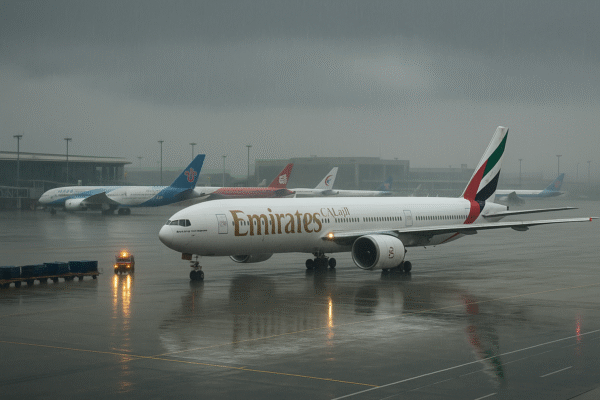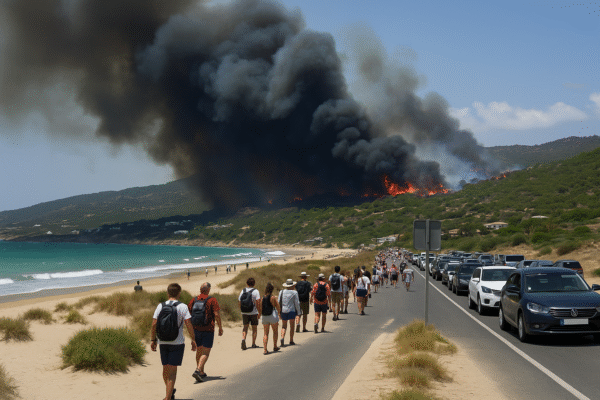A travel nightmare unfolded on Wednesday afternoon, August 6, 2025, when Birmingham Airport in the United Kingdom experienced a six-hour runway shutdown due to an emergency landing. The incident involved a Beechcraft B200 Super King Air aircraft that was forced to divert from its intended route due to a catastrophic landing gear malfunction. The small aircraft, carrying a pilot, co-pilot, and a single passenger, executed an emergency landing that disrupted operations at one of the UK’s key regional airports.
Emergency Landing Causes Major Runway Disruption
Shortly after 1:40 p.m., the aircraft reported a mechanical failure en route from Belfast, prompting the flight crew to initiate emergency protocols. The plane landed hard on Birmingham’s main runway, coming to a stop with its nose gear visibly compromised. While emergency response teams were on the scene in seconds and no injuries were reported, the impact on airport operations was profound.
The runway closure occurred during one of the busiest travel periods of the day, affecting both domestic and international flights. Airlines scrambled to reroute flights to nearby airports such as Manchester and East Midlands, while dozens of others faced delays and cancellations. Flight information boards quickly lit up with cancellations to destinations including Lisbon, Geneva, Amsterdam, and Dubai.
Travel Chaos Across Terminals
Thousands of passengers were caught in a web of disruption. Many were diverted to unfamiliar terminals, stranded without clear guidance, or faced prolonged waits for rebookings. Passengers who were set to connect via Birmingham faced missed connections and were left scrambling for accommodations or alternative transport.
Customer service desks were overwhelmed, with queues stretching for hours. Reports from the ground described tearful families, frustrated tourists, and business travelers caught in limbo, all awaiting updates. Many passengers commended the ground staff’s efforts under pressure but expressed frustration at the lack of timely communication.
Swift Response from Emergency Crews
Despite the travel upheaval, emergency services executed a textbook response. Fire, police, and medical teams ensured the safety of all on board, extinguished any potential hazards from overheated components, and secured the aircraft for investigation. The lone passenger, reportedly unharmed, disembarked calmly and was assisted by airport staff.
The aircraft was towed away by 6:00 p.m., allowing the airport to gradually reopen its runway. However, the residual impact of the closure meant that normal operations were not fully restored until well into the evening.
Ryanair Strike Adds Fuel to the Fire
To complicate matters further, Ryanair staff at 12 Spanish airports launched a strike on the same day, impacting flights bound for and from popular European holiday destinations. Flights that were already strained by the Birmingham incident now faced further disruption from staffing shortages and delayed takeoffs across Spain.
Affected destinations included coastal hotspots in Spain, and travelers experienced added confusion due to dual disruptions from different regions of the network. Travel experts noted that the confluence of events could not have come at a worse time, occurring at the peak of summer tourism.
Birmingham Airport Issues Statement
Birmingham Airport officials issued a formal statement acknowledging the incident and thanking passengers for their patience. “The safety of passengers and crew is always our top priority,” the statement read. “We understand the frustration caused by today’s delays and are working closely with airlines and service partners to resume normal operations.”
The airport confirmed that an investigation into the landing gear failure was underway, in collaboration with aviation safety authorities. A final report is expected in the coming weeks.
Long-Term Implications for UK Air Travel
This emergency has spotlighted the broader vulnerabilities of UK airports during unexpected events. With passenger numbers projected to increase in the post-pandemic travel boom, industry experts argue that airports must invest more in contingency planning and communication infrastructure.
Technology upgrades—including real-time alert systems, advanced mobile apps for rebooking, and more responsive baggage management—are now seen as critical. Moreover, the incident exposed the fragility of regional airport networks when key infrastructure, like a single runway, becomes unavailable.
Conclusion: Lessons in Aviation Crisis Management
The Birmingham Airport emergency landing may not have resulted in physical harm, but it has served as a wake-up call for aviation authorities and the travel industry. From better communication to strategic planning and passenger support, this incident underscores the need for stronger resilience in air travel systems.
With investigations ongoing, passengers are encouraged to stay informed via official airline and airport channels. As summer travel peaks, the focus must shift to enhancing passenger experience and ensuring that even in emergencies, chaos does not define the journey.
For more travel news like this, keep reading Global Travel Wire















